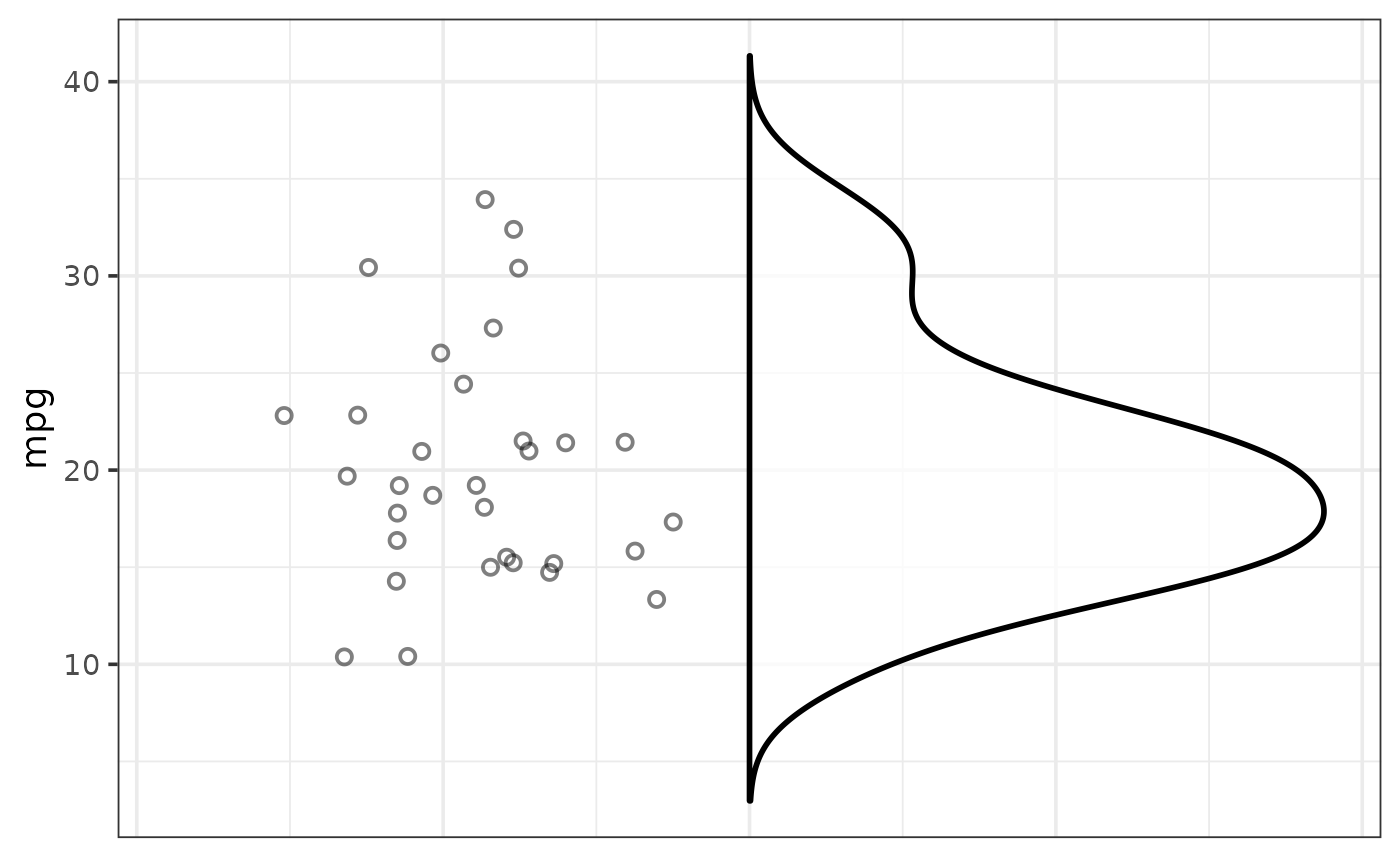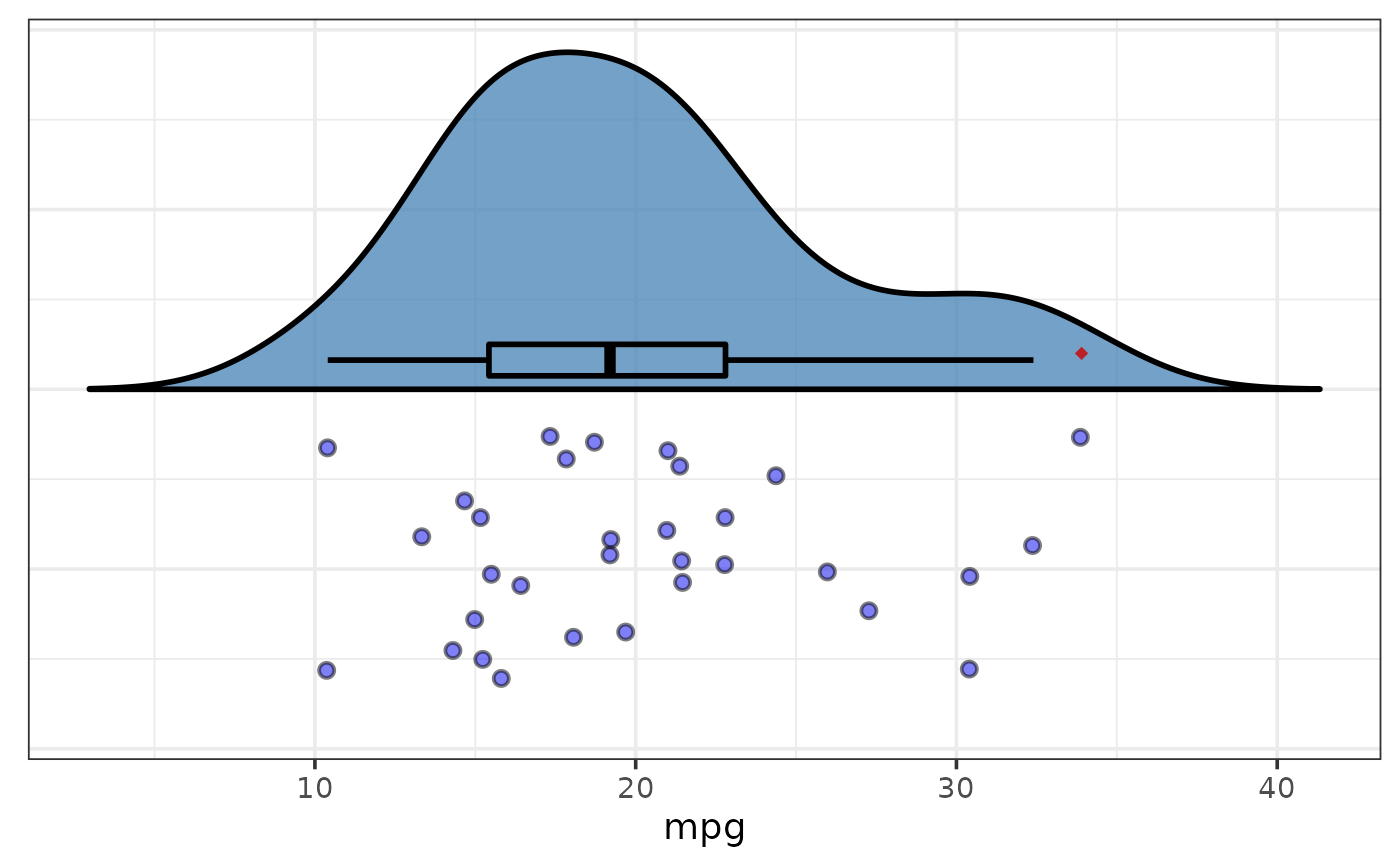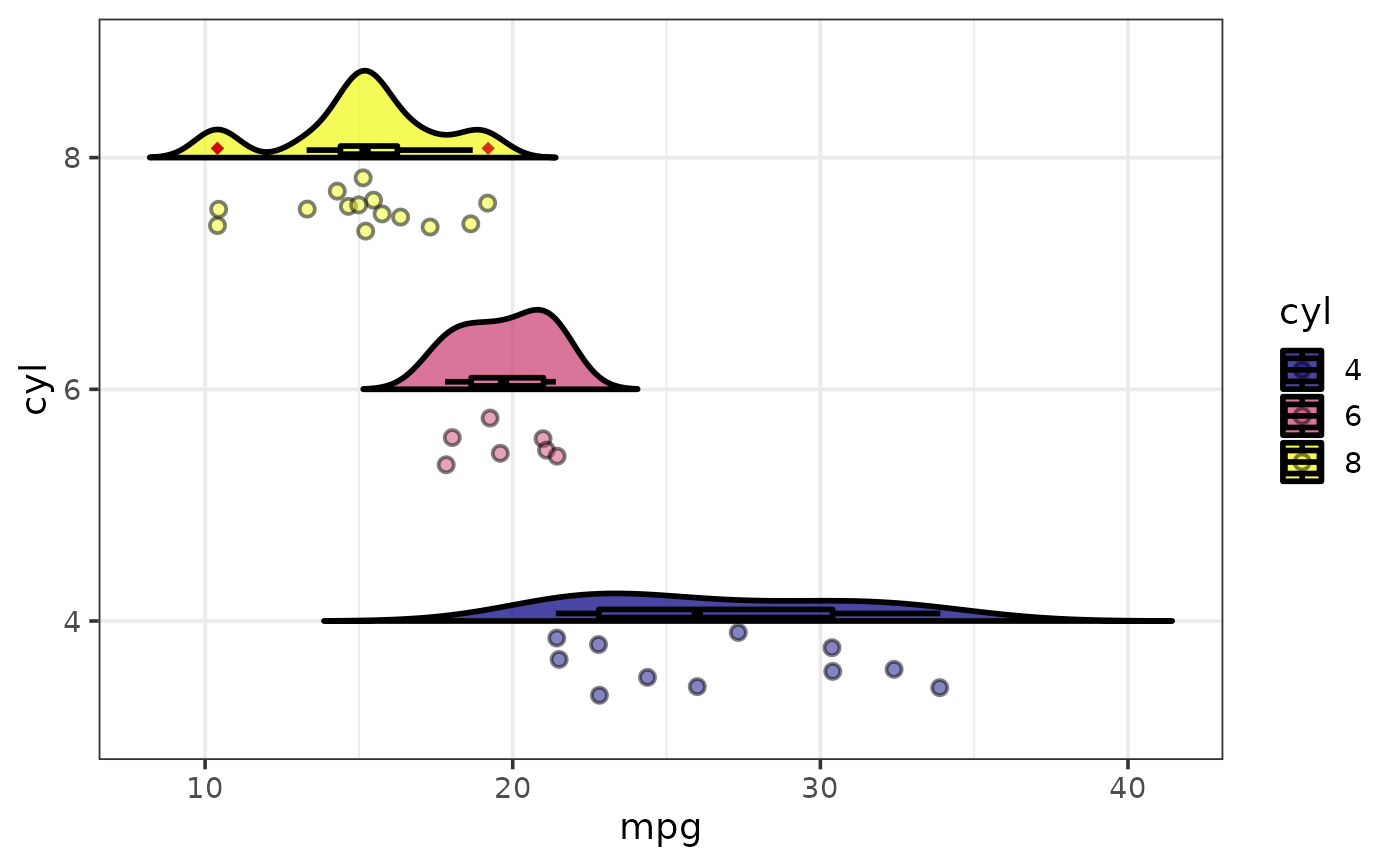Easily generate hybrid half-violin/half-scatter plots AKA "rain cloud plots", with or without overlaid box plots, using ggplot2 and gghalves. Like other plot_* functions, plot_raincloud() provides a simplified argument-based customization interface for common modifications and yields plots that can be further modified with ggplot2 syntax. See this blog post for an introduction to ggplot2.
plot_raincloud(
data,
y,
x = NULL,
fill_var = NULL,
violin_colour = "black",
violin_fill = NULL,
violin_side = c("r", "l"),
violin_line_size = 1,
violin_alpha = 0.75,
violin_trim = FALSE,
violin_quantiles = NULL,
point_colour = "black",
point_fill = NULL,
point_side = c("l", "r"),
point_shape = c("circle", "square", "diamond", "triangle up", "triangle down"),
point_size = 2,
point_alpha = 0.5,
point_line_size = 1,
point_position = "dodge2",
box_plot = FALSE,
box_half = FALSE,
box_colour = "black",
box_fill = NULL,
box_side = c("r", "l"),
box_alpha = 0,
box_line_size = 1,
box_line_type = c("solid", "dashed", "dotted", "dotdash", "longdash", "twodash"),
box_whisker_coef = 1.5,
box_width = 0.1,
box_error_bars = FALSE,
box_nudge = 0.015,
box_outlier_colour = "red3",
box_outlier_fill = NULL,
box_outlier_size = 2,
box_outlier_shape = 18,
box_outlier_alpha = 0.8,
xlab = NULL,
ylab = NULL,
title = NULL,
title_hjust = 0.5,
caption = NULL,
caption_hjust = 0,
fill_var_title = NULL,
ylim = c(NA, NA),
ybreaks = ggplot2::waiver(),
transform_y = FALSE,
y_transformation = "log10",
y_var_labs = ggplot2::waiver(),
x_var_order = NULL,
x_var_labs = NULL,
fill_var_order = NULL,
fill_var_labs = NULL,
fill_var_values = NULL,
palette = c("plasma", "C", "magma", "A", "inferno", "B", "viridis", "D", "cividis",
"E"),
palette_direction = c("d2l", "l2d"),
palette_begin = 0,
palette_end = 1,
coord_flip = FALSE,
greyscale = FALSE,
theme = c("bw", "classic", "grey", "light", "dark", "minimal"),
text_size = 14,
font = c("sans", "serif", "mono"),
facet_var = NULL,
facet_var_order = NULL,
facet_var_labs = NULL,
facet_var_strip_position = c("top", "bottom"),
facet_var_text_bold = TRUE,
legend_position = c("right", "left", "top", "bottom"),
omit_legend = FALSE,
aesthetic_options = FALSE
)Arguments
- data
A data frame or tibble containing the dependent measure "y" and any grouping variables.
- y
A numeric variable you want to obtain rain cloud plots for (quoted or unquoted), e.g. y = "variable" or y = variable.
- x
A categorical variable you want to obtain separate rain cloud plots of y for (optional; quoted or unquoted), e.g. x = "variable" or x = variable.
- fill_var
Use if you want to assign a variable to the fill colour of the half-violin and scattered points on the plot, e.g. fill_var = "grouping_var" or fill_var = grouping_variable. Produces separate rain cloud plots for each level of the fill variable. See
aesfor details. N.B. If you intend to add box plots (via box_plot = TRUE), the same variable should be assigned to both the x-axis and fill_var, otherwise the box plots will not show up in the correct locations.- violin_colour
Outline colour to use for the half-violin plot segment of the rain cloud plot. Default is "black". You can use
colour_optionsto see many of the available options.- violin_fill
Fill colour to use for the half-violin plot segment of the rain cloud plot. You can use
colour_optionsto see many of the available options. To assign different colours to groups of a variable mapped to x or fill_var, use fill_var, palette, and/or fill_var_values instead.- violin_side
Set to "r" (default) if you want the half-violin plot segment to be draw on the right side of the rain cloud plot midline (or "l" for left).
- violin_line_size
Adjusts the thickness of the half-violin plot outline.
- violin_alpha
This adjusts the transparency/opacity of the half-violin plot component of the rain cloud plot, with valid values ranging from 0 = 100% transparent to 1 = 100% opaque.
- violin_trim
Set this to TRUE if you want to trim the tails of the half-violin plot component of the rain cloud plot.
- violin_quantiles
Accepts a vector of quantile values to draw as lines on the half-violin plot. For example, to draw a line at the median of y, you would set this to 0.5.
- point_colour
Outline colour to use for the scatter plot segment of the rain cloud plot. Default is "black". You can use
colour_optionsto see many of the available options.- point_fill
Fill colour to use for the scatter plot segment of the rain cloud plot. You can use
colour_optionsto see many of the available options. To assign different colours to groups of a variable mapped to x or fill_var, use fill_var, palette, and/or fill_var_values instead.- point_side
Set to "l" (default) if you want the box plot to be draw on the left side of the rain cloud plot midline (or "r" for right).
- point_shape
Shape to use for the scatter plot points. Options include
geom_pointshapes that have both colour and fill aesthetics: "circle", "square", "diamond", "triangle up", and "triangle down".- point_size
Adjusts the size of the points in the scatter plot portion of the rain cloud plot.
- point_alpha
This adjusts the transparency/opacity of the scattered points, with valid values ranging from 0 = 100% transparent to 1 = 100% opaque.
- point_line_size
Adjusts the scatter plot point outline thickness.
- point_position
This typically does not need to be modified in a rain cloud plot. See the "position adjustment" section of the ggplot2 reference page for options and detailed information.
- box_plot
Set this to TRUE to add a box plot of y to the rain cloud plot.
- box_half
Set to TRUE if you only want half of a box plot added (ignored if box_plot = FALSE).
- box_colour
Outline colour to use for the box plots (ignored if box_plot = FALSE). Default is "black". You can use
colour_optionsto see many of the available options. To assign different colours to groups of a variable mapped to x or fill_var, use fill_var, palette, and/or fill_var_values instead.- box_fill
Fill colour to use for the box plots (ignored if box_plot = FALSE). You can use
colour_optionsto see many of the available options. To assign different colours to groups of a variable mapped to x or fill_var, use fill_var, palette, and/or fill_var_values instead.- box_side
Set to "r" (default) if you want the box plot to be draw on the right side of the rain cloud plot midline (or "l" for left). Ignored if box_plot = FALSE.
- box_alpha
This adjusts the transparency/opacity of the scattered points, with valid values ranging from 0 = 100% transparent to 1 = 100% opaque (ignored if box_plot = FALSE).
- box_line_size
Adjusts the thickness of box plot lines (ignored if box_plot = FALSE).
- box_line_type
Used to specify the type of line to use for box plots (ignored if box_plot = FALSE). Options include: "solid", "dashed", "dotted", "dotdash", "longdash", and "twodash".
- box_whisker_coef
The length of box plot whiskers as a multiple of the interquartile range (marked by the box length). Default is the standard 1.5. Ignored if box_plot = FALSE.
- box_width
Controls the box width (ignored if box_plot = FALSE).
- box_error_bars
Set to TRUE if you want to add error bar lines to the ends of the box plot whiskers (ignored if box_plot = FALSE).
- box_nudge
Controls the distance between the box plot and mid line of the overall rain cloud plot, where 0 is touching the mid-line and higher values displace the box plot further in the direction specified with the box_side argument. Ignored if box_plot = FALSE.
- box_outlier_colour
Controls the colour of the boxplot outlier indicator points. If box_outlier_shape is set to a value between 21 and 25 then it controls the outline colour instead of the overall colour. Ignored if box_plot = FALSE.
- box_outlier_fill
If box_outlier_shape is set to a value between 21 and 25, this controls the fill colour of the box plot outlier indicator points. Ignored if box_plot = FALSE or box_outlier_shape is a value outside of 21-25 since these other shapes do not have a fill aesthetic.
- box_outlier_size
Controls the size of the box plot outlier indicator points. Ignored if box_plot = FALSE.
- box_outlier_shape
Controls the shape of the box plot outlier indicator points. Ignored if box_plot = FALSE. To see examples of the available options in a web browser, set the aesthetic_options argument to TRUE.
- box_outlier_alpha
This adjusts the transparency/opacity of the box plot outlier indicator points, with valid values ranging from 0 = 100% transparent to 1 = 100% opaque. Ignored if box_plot = FALSE.
- xlab
Specify/overwrite the x-axis label using a character string, e.g. "x-axis label"
- ylab
Specify/overwrite the y-axis label using a character string, e.g. "y-axis label"
- title
Add a main title to the plot using a character string, e.g. "Violin graph of X"
- title_hjust
Left-to-right/horizontal justification (alignment) of the main plot title. Accepts values from 0 (far left) to 1 (far right). Default is 0.5 (centre).
- caption
Add a figure caption to the bottom of the plot using a character string.
- caption_hjust
Left-to-right/horizontal justification (alignment) of the caption. Accepts values from 0 (far left) to 1 (far right). Default is 0 (left).
- fill_var_title
If a variable has been assigned to fill using fill_var, this allows you to modify the variable label in the plot legend.
- ylim
specify the y-axis limits, e.g. ylim = c(lower_limit, upper_limit). Use NA for the existing minimum or maximum value of y, e.g. the default is ylim = c(NA, NA)
- ybreaks
This allows you to change the break points to use for tick marks on the y-axis.
seqis particularly useful here. Seescale_y_continuousfor details. If ybreaks is specified, then ylim should be also.- transform_y
Would you like to transform the y axis? (TRUE or FALSE)
- y_transformation
If transform_y = TRUE, this determines the transformation to be applied. Common choices include "log10" (the default), "log2", "sqrt", or "exp". See
scale_continuousfor details.- y_var_labs
Allows you to modify the labels displayed with the y-axis tick marks. See
scale_continuousfor details.- x_var_order
If a variable has been assigned to x, this allows you to modify the order of the variable groups, e.g. x = grouping_variable, x_var_order = c("group_2", "group_1"). See
fct_relevelfor details.- x_var_labs
If a variable has been assigned to x, this allows you to modify the labels of the variable groups, e.g. x = grouping_variable, x_var_labs = c("group_1_new_label" = "group_1_old_label", "group_2_new_label" = "group_2_old_label"). See
fct_recodefor details.- fill_var_order
If a variable has been assigned to fill using fill_var, this allows you to modify the order of the variable groups, e.g. fill_var = grouping_variable, fill_var_order = c("group_2", "group_1"). See
fct_relevelfor details.- fill_var_labs
If a variable has been assigned to fill using fill_var, this allows you to modify the labels of the variable groups, e.g. fill_var = grouping_variable, fill_var_labs = c("group_1_new_label" = "group_1_old_label", "group_2_new_label" = "group_2_old_label"). See
fct_recodefor details.- fill_var_values
If a variable has been assigned to fill using fill_var, this allows you to modify the colours assigned to the fill of each of the variable groups, e.g. fill_var = grouping_variable, fill_var_values = c("blue", "red"). See
scale_fill_manualfor details. For the colour options available in base R, seecolour_options.- palette
If a variable is assigned to fill_var, this determines which viridis colour palette to use. Options include "plasma" or "C" (default), "magma" or "A", "inferno" or "B", "viridis" or "D", and "cividis" or "E". See this link for examples. You can override these colour palettes with fill_var_values.
- palette_direction
Choose "d2l" for dark to light (default) or "l2d" for light to dark.
- palette_begin
Value between 0 and 1 that determines where along the full range of the chosen colour palette's spectrum to begin sampling colours. See
scale_fill_viridis_dfor details.- palette_end
Value between 0 and 1 that determines where along the full range of the chosen colour palette's spectrum to end sampling colours. See
scale_fill_viridis_dfor details.- coord_flip
Flips the x and y axes, which makes this type of plot look like a rain cloud (half-violin plot "cloud" on top of scattered point "rain drops"). See
coord_flipfor details.- greyscale
Set to TRUE if you want the plot converted to greyscale. Note that this will override colours you may have specified with other arguments.
- theme
Adjusts the theme using 1 of 6 predefined "complete" theme templates provided by ggplot2. Currently supported options are: "classic", "bw" (the elucidate default), "grey" (the ggplot2 default), "light", "dark", & "minimal". See
theme_bwfor more information.- text_size
This controls the size of all plot text. Default = 14.
- font
This controls the font of all plot text. Default = "sans" (Arial). Other options include "serif" (Times New Roman) and "mono" (Courier New).
- facet_var
Use if you want separate plots for each level of a grouping variable (i.e. a faceted plot), e.g. facet_var = "grouping_variable" or facet_var = grouping_variable. See
facet_wrapfor details.- facet_var_order
If a variable has been assigned for faceting using facet_var, this allows you to modify the order of the variable groups, e.g. facet_var = grouping_variable, facet_var_order = c("group_2", "group_1"). See
fct_relevelfor details.- facet_var_labs
If a variable has been assigned for faceting using facet_var, this allows you to modify the labels of the variable groups which will appear in the facet strips, e.g. facet_var = grouping_variable, facet_var_labs = c("group_1_new_label" = "group_1_old_label", "group_2_new_label" = "group_2_old_label"). See
fct_recodefor details.- facet_var_strip_position
If a variable has been assigned for faceting using facet_var, this allows you to modify the position of the facet strip labels. Sensible options include "top" (the default) or "bottom".
- facet_var_text_bold
If a variable has been assigned for faceting using facet_var, this allows you to use boldface (TRUE/default or FALSE) for the facet strip label text.
- legend_position
This allows you to modify the legend position. Options include "right" (the default), "left", "top", & "bottom".
- omit_legend
Set to TRUE if you want to remove/omit the legends.
- aesthetic_options
If set to TRUE, opens a web browser to the tidyverse online aesthetic options vignette.
Value
A ggplot rain cloud plot.
References
Wickham, H. (2016). ggplot2: elegant graphics for data analysis. New York, N.Y.: Springer-Verlag.
Allen, M., Poggiali, D., Whitaker, K., Marshall, T. R., & Kievit, R. A. (2019). Raincloud plots: a multi-platform tool for robust data visualization. Wellcome open research, 4.
Examples
data(mtcars) #load the mtcars data
#basic raincloud plot
plot_raincloud(mtcars, y = mpg)
 # \donttest{
#set coord_flip = TRUE to flip the x and y axes so it looks like a rain cloud
#add a box plot with box_plot = TRUE
#add fill colours with violin_fill and point_fill
plot_raincloud(mtcars, mpg,
coord_flip = TRUE, box_plot = TRUE,
violin_fill = "steelblue", point_fill = "blue2")
# \donttest{
#set coord_flip = TRUE to flip the x and y axes so it looks like a rain cloud
#add a box plot with box_plot = TRUE
#add fill colours with violin_fill and point_fill
plot_raincloud(mtcars, mpg,
coord_flip = TRUE, box_plot = TRUE,
violin_fill = "steelblue", point_fill = "blue2")
 #split the plot by a grouping variable with the x argument
#assign a variable to fill colour with the fill_var argument
#it is recommended to assign the same variable to x and fill_colour or box
#plots will not show up correctly
plot_raincloud(mtcars, mpg, x = cyl, fill_var = cyl,
coord_flip = TRUE, box_plot = TRUE)
#split the plot by a grouping variable with the x argument
#assign a variable to fill colour with the fill_var argument
#it is recommended to assign the same variable to x and fill_colour or box
#plots will not show up correctly
plot_raincloud(mtcars, mpg, x = cyl, fill_var = cyl,
coord_flip = TRUE, box_plot = TRUE)
 # }
# }